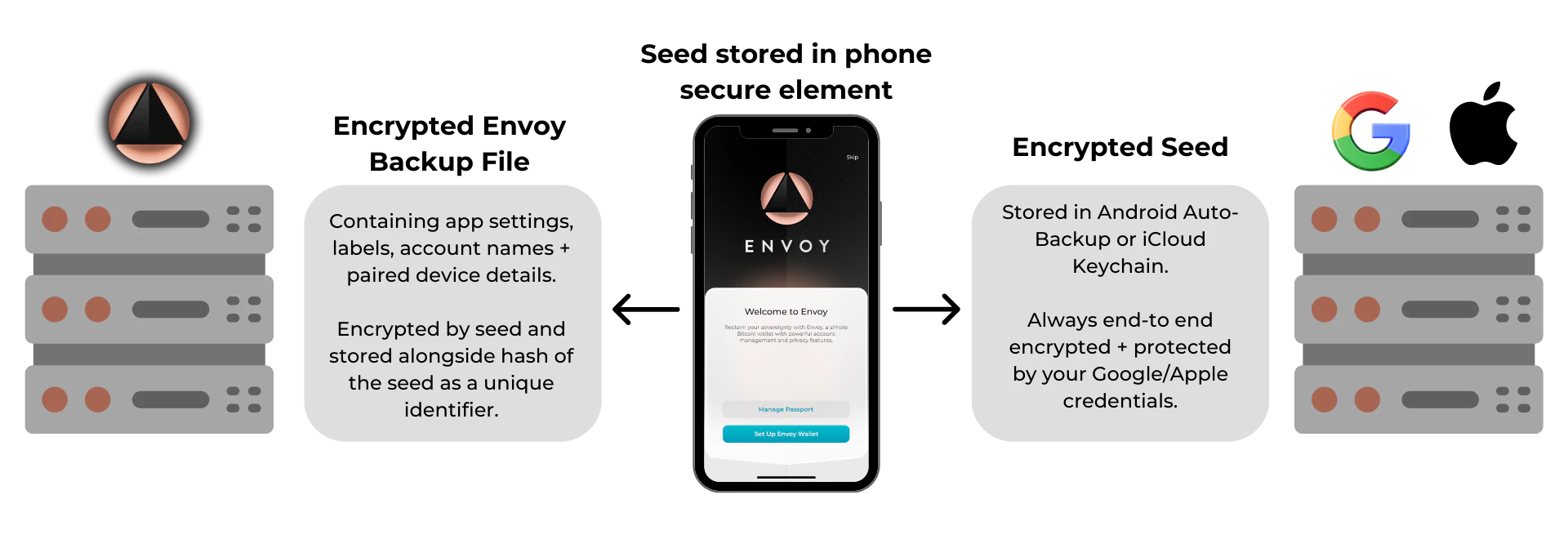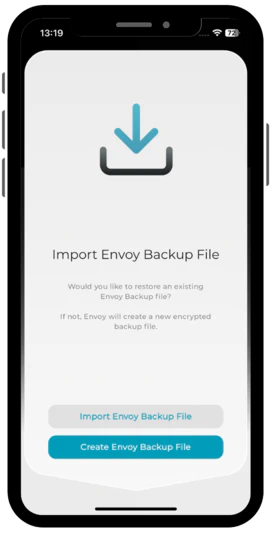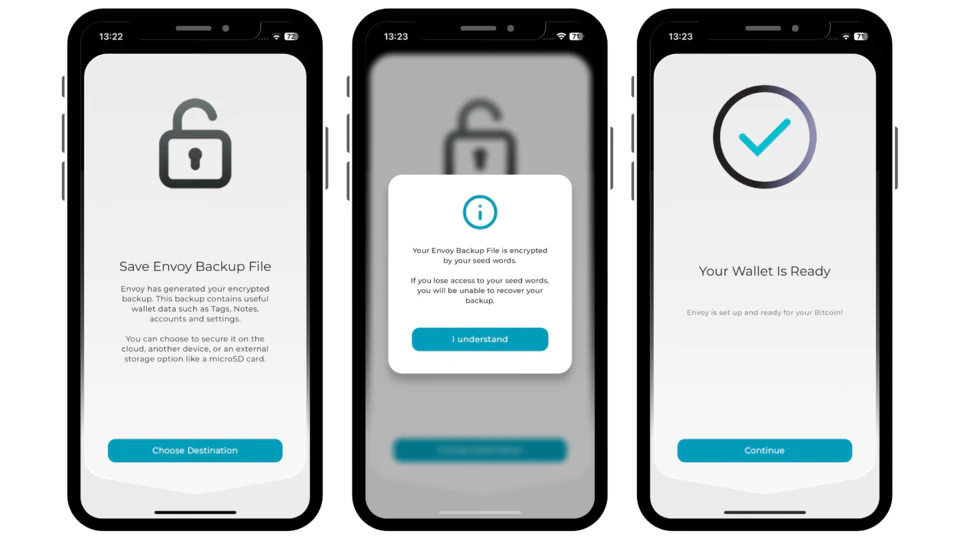Setting up a mobile wallet in Envoy is perfect for storing smaller amounts of Bitcoin for more frequent spending, while still ensuring you are in full control of all of your funds.
At no time, under any circumstances, are the seed words for your Passport stored using any of the methods outlined in this page. To see how to backup Passport, click here .
Types of Envoy Backup
Magic Backup
Here’s how Envoy Magic Backups work:
- Envoy generates a Bitcoin seed for your Envoy mobile wallet and stores it on your phone’s secure element.
- Since most users have iCloud Keychain or Android Auto-Backup enabled, the seed is automatically synced to your other iOS or Android devices – fully end-to-end encrypted, without needing to give Envoy permission to access your iCloud or Google account.
- Envoy then creates a backup file containing your app settings, account labels, and other non-sensitive app data. We call this the Envoy Backup File. The backup file is end-to-end encrypted with your Envoy seed, meaning Foundation can never see the contents. It does not contain your seed words.
- The fully encrypted Envoy Backup File is uploaded to Foundation’s servers, alongside a hash of the seed (a cryptographic representation of the seed, not the seed itself!) so that we can ensure no one else can attempt to download your backup without proving knowledge of your seed phrase.
- There is no Foundation user account – all you need is access to your Apple or Google account and you’re all set.

Users opting for this Magic Backup option can also choose to view their Envoy seed words from the backup menu at any time.
Manual Backup
The option to Manually Configure Seed Words upon Envoy wallet setup is for users that do not want to leverage automatic cloud backups and would instead prefer to manage and/or import their own seed words for their Envoy mobile wallet. Here is how they work:
- Envoy generates a new seed or the user imports their own seed from elsewhere
- The user is asked to verify they have manually backed up the seed words
- Envoy then creates a backup file and asks the user to provide a storage location for it. This file contains app settings, account labels, and other non-sensitive app data. We call this the Envoy Backup File. The backup file is end-to-end encrypted with your Envoy seed, meaning Foundation can never see the contents. It does not contain your Envoy seed words.
That’s it! You now have 12 seed words and an accompanying file containing wallet metadata. It is strongly advisable to store these two pieces of information away from your phone such that they can be leveraged in the event that something were to happen to your phone running Envoy. After set up, subsequent metadata updates must be manually saved from the Envoy backup menu.
Most Bitcoin seed word backups are stored in plain text. This makes them extremely sensitive information. Anyone with access to them can steal your Bitcoin! Choose your storage location of this type of backup extremely carefully.
Backup Recovery
Magic Recovery
If you lose your phone or delete the Envoy app, restoring your Envoy Wallet takes only a few seconds with our Magic Backup. Here’s how you do that:
- Ensure you are signed in to your iCloud or Google account
- Install Envoy and tap Set Up Envoy Wallet on the opening screen.
- Choose your privacy setting and tap Continue.
- Envoy will automatically restore your wallet.
That’s it!
Here’s what happens under the hood:
- Envoy checks the secure element on your phone and looks for the seed.
- If it discovers a seed on the secure element, Envoy hashes the seed and sends the hash to our server. This only proves your knowledge of the seed and does not reveal your seed itself to Foundation.
- If it does not discover a seed, it downloads the encrypted seed backup from your iCloud Keychain or Android Auto-Backup and restores the seed to the phone’s secure element. Envoy then hashes the seed and sends the hash to the Foundation server.
- The server then sends the encrypted Envoy Backup file to Envoy.
- Envoy uses the seed to decrypt the Envoy Backup file locally and restores all user settings, account labels, and other app data, so your Envoy looks identical to the last time you left it.
Android users recovering their magic backup wallet onto a new phone will need to perform a full Google backup restoration on the new device.
Manual Recovery
If you are not a Magic Backup user, there are two ways to recover your Envoy Wallet. The first is to import your seed words; this is useful in a scenario where you have completely lost access to Envoy, e.g., losing your phone.
- Upon opening Envoy for the first time, you will be met with the welcome screen. Tap Set Up Envoy Wallet. If you are an existing Envoy user, tap the + in the top right corner of the Accounts screen, then skip to step 4.
- Choose your privacy setting. Here you can choose between the following two options:
- Better Performance - Envoy’s connection will be fast and reliable with Tor turned off
- Improved Privacy - Tor will be turned on for improved privacy. This can sometimes make Envoy’s connection unstable
Envoy users with their own Bitcoin node can connect to it at this stage by tapping ‘Add Node’ from the top right corner of the screen.
After making your privacy setting choice, tap Continue.
Tap Manually Configure Seed Words.
Tap Import Seed.
Choose the length of the seed to be imported. This can be 12 or 24 words. Alternatively you can import a SeedQR format from Passport’s Key Manager .

- If you chose to import via seed words, enter them carefully now.

- If importing a seed from an existing Envoy wallet, you now have the opportunity to import the associated backup file from your chosen storage method.

If the seed was generated elsewhere and you do not have an Envoy backup file, tap Create New Backup and choose a location for it to be stored.

- Your wallet setup is now complete and you are ready to send and receive Bitcoin! Envoy will automatically load any balances and transaction history.
However, if you still have access to the phone running Envoy, but want to easily migrate your wallet to a new phone for example, you can follow these steps.
- Install Envoy on the new device.
- Tap Setup Envoy Wallet.
- Choose your privacy setting and tap Continue.
- Tap Manually Configure Seed Words.
- Tap Import Seed.
- Tap Import with QR code.

- On your existing Envoy wallet, tap the icon in the top left corner of the screen, then tap Backups.
- Ensure you are in a private location, then tap View Envoy Seed.

- On the new phone, in Envoy, scan the QR code being displayed.
- Import your Envoy Wallet backup file from your chosen storage method (if you have one).
- Your Envoy Wallet is now restored onto your new phone and Envoy will automatically load any balances and transaction history.
Backups FAQ
Under no circumstances are your Passport seed words ever shared with Envoy.
No, but we’ll soon be adding that as an option for advanced users.
Basically nothing. We store a hash of your Envoy seed words as your identifier alongside an encrypted blob of data containing your Envoy wallet metadata. We cannot decrypt the data without knowledge of your seed words.
We store app settings, account names (including connected Passport accounts) and transaction notes and tag data.
If someone were to gain access to your iCloud/Google account, they could in theory download Envoy, recover your mobile wallet and spend the funds within. We strongly recommend securing your accounts with a strong password and 2FA.
It is also worthwhile reminding you here that the Envoy Mobile wallet is not designed for storing large amounts of Bitcoin. For that, we recommend Passport
Head to the Envoy settings, then tap Backups > Erase Wallets and Backups. Ensure you have robust backups in place before carrying out this step.
Head to the Envoy settings, then tap Backups > Download Envoy Backup File. This will open your phone’s file browser for you to store wherever you like.